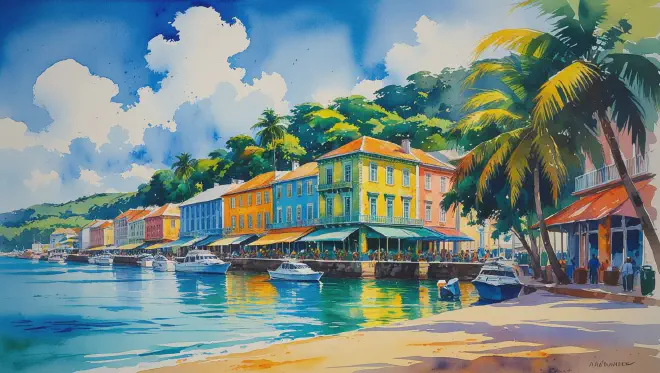Introduction
Just saying the name “Mauritius” seems to carry with it a faint sweet fragrance drifting through the air. This small island nation floating in the Indian Ocean radiates a unique charm where African, Indian, Chinese, and European cultures have layered upon the volcanic soil that gave birth to this land.
The capital, Port Louis, true to its name, retains strong traces of its French colonial past while developing into a multicultural city woven together by Creole, Indian, and Chinese communities. Sugar cane fields cover most of the island, and mountains that still hold glimpses of the primeval forests where dodo birds once walked stretch toward the sky.
Port Louis, flourishing as a port city, possesses both the beauty of colonial architecture with white walls and red roofs, and the vibrant, lived-in character where market bustle mingles with the aroma of spices. Blessed with a warm climate year-round, the summer season from November to May is also the rainy season, but after brief, intense downpours, beautiful rainbows invariably appear across the sky.
These three days and two nights on this island would surely become an experience where time itself flows differently.

Day 1: An Afternoon Arrival Wrapped in Ocean Breeze
After a long flight from Narita, I landed at Sir Seewoosagur Ramgoolam International Airport around 2 PM. The Mauritian sea I glimpsed from the aircraft was a much more vivid turquoise blue than any photograph could capture, with breathtakingly beautiful gradations shifting from coral reef shallows to deep ocean waters.
The drive from the airport to Port Louis took about an hour. The scenery visible through the taxi window was somewhat different from the tropical paradise I had imagined. Amidst endless sugar cane fields, colorful towers of Hindu temples would suddenly appear, and Creole-style wooden houses were scattered throughout. Rajesh, my driver, mixing fluent English and French, smiled and said, “In Mauritius, it’s perfectly normal for one person to speak four languages.”
Upon entering Port Louis city center, the atmosphere completely transformed. Colonial buildings mixed with modern structures, and narrow alleys were lined with Indian shops and Chinese restaurants. After checking into my hotel, “Le Labourdonnais Waterfront,” and dropping off my luggage, I ventured outside just after 4 PM.
I decided to start by walking through the city center. The Caudan Waterfront, a shopping area converted from former port facilities, offers beautiful sunset views from its ocean-facing promenade. Being a weekday afternoon, there were few tourists, and locals were leisurely enjoying their walks.
Yachts and fishing boats moored in the harbor, with the silhouette of Le Morne mountain visible in the distance. The air carried humidity, but each time the sea breeze brushed against my cheek, it brought a pleasant coolness. The vanilla tea I ordered at a café terrace filled my mouth with the rich aroma of Mauritian vanilla beans, seeming to heal the fatigue of my long journey.
For dinner, I went to a small eatery called “Shop and Eat,” recommended by a local. The menu was filled with dishes I’d never heard of, but Madame Lee, the owner, said, “For first-time customers, I have a special set,” and brought me “rougaille,” a representative Creole dish.
This fish dish simmered in a spicy tomato-based sauce also included sausage and herbs. The accompanying rice had larger grains than Japanese rice, with a subtle coconut flavor. Despite the spiciness, there was a gentle sweetness, and though I started eating cautiously, I found my plate empty before I knew it.
“Delicious, wasn’t it? In Mauritian cooking, love is the most important spice,” Madame Lee laughed. Her grandfather was a laborer who immigrated from India, her grandmother was from Madagascar, and her husband was Chinese. “That’s why my cooking contains flavors from everyone’s homeland.”
Walking back to the hotel through the night streets, I encountered light and music spilling from the Caudan Waterfront casino, handmade accessories sold at street stalls, and the rhythm of sega music carried on the night breeze. On this first night, just touching upon a fragment of this island’s complex and rich culture made my heart feel lighter.
Day 2: Encounters with Vibrant Culture
Around 6 AM, I woke to the sound of birds singing. Looking down at Port Louis from my balcony, the city floated dimly in morning mist, with mountains beyond the rooftops tinged purple. The air was more humid than yesterday, suggesting the approaching rainy season.
The hotel breakfast was a combination of French bread, tropical fruits, and Mauritian coffee. The sweetness of papaya and mango mingled in my mouth, while the deep bitterness of coffee provided balance. It was a luxurious morning time impossible to experience in Japan.
In the morning, I first headed to the Central Market. About a 10-minute walk from the city center, as the old iron-frame building came into view, the aroma of spices was already wafting through the air. Inside the market was more lively than I had imagined, with women’s voices selling vegetables and fruits echoing throughout, while souvenir shops for tourists also lined the aisles.
Curry leaves, coriander, cardamom, cinnamon. Stopping in front of a shop with mountains of spices, the owner offered me small bags saying, “Smell these.” Each spice’s aroma was far more intense than anything I could buy in Japan, sharp enough to make my nose tingle. “This is the real fragrance,” the owner said proudly, and I could understand why.
At the neighboring fruit shop, fruits of shapes and colors I’d never seen were displayed. “Jumbo lychees,” large lychees, and “jamrose,” red fruits shaped like pears. The jamrose the shopkeeper let me sample had a subtle acidity and elegant sweetness, with a mysterious rose-like fragrance.
In the afternoon, I headed to Aapravasi Ghat. This is where laborers immigrating from India in the 19th century first set foot, and it’s now registered as a World Heritage site. The small museum displays the living and working conditions of immigrants from that era, allowing visitors to understand how Mauritius’s multicultural society was formed.
While viewing the exhibits, a guide approached me. Deepak, a man in his seventies, said his great-grandfather was also an immigrant from India. “Our ancestors left their homeland and began new lives on this island. There were many hardships, but now we live with pride as Mauritians.”
Listening to his story while spending the afternoon on a terrace overlooking the harbor, thinking of their ancestors’ homeland beyond the blue Indian Ocean, I felt the weight of this island’s history.
In the evening, the intense downpours characteristic of the rainy season began. I took shelter in a nearby café, and after about 30 minutes, the rain stopped and a magnificent rainbow appeared in the sky. The locals, accustomed to this, laughed and folded their umbrellas, saying, “It’s always like this.”
For dinner, I went to “Dragon Palace,” a Chinese restaurant in Chinatown. Their “mine” (noodle) dishes, with Chinese cuisine enhanced by Creole spices, offered a unique fusion cooking experience specific to Mauritius. The shrimp and vegetable fried noodles had a soy sauce base with the aroma of chili and curry leaves, creating a completely different taste from Chinese food in Japan.
After dinner, I went to see a sega music show at the Port Louis Theatre. Sega is traditional Mauritian music, said to originate from songs and dances that African slaves performed while thinking of their homeland. The dancers’ movements to the drum rhythms were powerful, naturally inspiring applause from the audience.
After the music ended, one performer said, “Sega is the song of our hearts. In sad times and happy times, with sega, everything is okay.” This left a strong impression. Walking back to the hotel, sega rhythms continued playing in my head, naturally making my steps lighter.
Day 3: Farewell and Melodies of Memory
On the final morning, I decided to wake up a bit early and take a walk through Port Louis. At 7 AM, the city was wrapped in quietude before the rush hour began. Near the bus terminal, an old man was making “farata,” Indian-style pancakes for breakfast at his stall, and he shared some fresh ones with me. The batter had curry flavoring, with potato and onion filling inside. Walking through the morning with hot farata in my mouth might have been the most luxurious time of this entire trip.
Using the time before checkout, I visited the Central Market one last time. Seeing it from a different perspective revealed new discoveries. Handmade basket bags, Mauritian tea, and small dodo bird figurines. While choosing souvenirs, faces of people I’d met over these two days came to mind one after another.
Madame Lee was busy working in her kitchen as usual, and when she spotted me, she waved saying, “Are you leaving already? Next time, stay longer.” The spice shop owner put cardamom in a small bag, saying, “Even when you return to Japan, don’t forget real spices.”
Leaving the hotel at 1 PM and heading to the airport, I burned the last scenes of Mauritius into my memory through the taxi window. Mountains visible beyond sugar cane fields, colorful houses scattered here and there, and the glittering Indian Ocean in the distance.
Rajesh was the same taxi driver from the first day, and he asked, “It was a short stay, but did you like Mauritius?” When I answered, “I liked it very much. I’ll definitely come back,” he smiled and said, “Next time, bring your family too. Mauritius is also a place for families to enjoy.”
After completing boarding procedures at the airport, while drinking my last Mauritian coffee in the departure lounge, I reflected on these three days. Though it was only a brief two nights and three days, the warmth of the people I met on this island, the rich cuisine woven from diverse cultures, and above all, the gentle atmosphere that seemed to embrace everything.
Looking down at Mauritius from the aircraft, it felt much more familiar than when I had first seen it. The small island surrounded by coral reefs sparkled like a jewel in the blue Indian Ocean. Surely there will come a day when I return. Next time, I want to take more time to explore the depths of this island.
The faint spice aroma that lingered on the towel distributed on the plane became my final memory of this trip.
Conclusion: What Felt Real Despite Being Imaginary
This two-night, three-day travel journal of Port Louis, Mauritius, was drawn entirely from imagination—a completely fictional journey. Yet while writing, I experienced the illusion of actually walking through those places, breathing that air, and tasting those dishes.
The warmth of Madame Lee’s rougaille, the spice aromas of the Central Market, the beauty of rainbows appearing after downpours, the lingering rhythm of sega music in my heart. These were all products of imagination, yet they remain in my mind as genuine memories.
Travel might not simply be about moving from place to place, but about opening one’s heart to new worlds. Even if that world exists only in imagination, sincere engagement can create authentic experiences. Through Mauritius’s multicultural charm, the warmth of its people, and the different flow of time, we can feel something unattainable in daily life.
Now that this imaginary journey has ended, my desire to actually visit Mauritius has grown stronger. How different or similar might the real scenery be compared to what I imagined? This curiosity to find out might be one of the mysterious charms that imaginary travel possesses.
Two fictional nights and three days spent on a small island floating in the Indian Ocean. This experience remains in my heart with the same richness as any real journey would have had.

